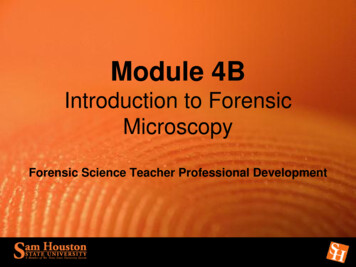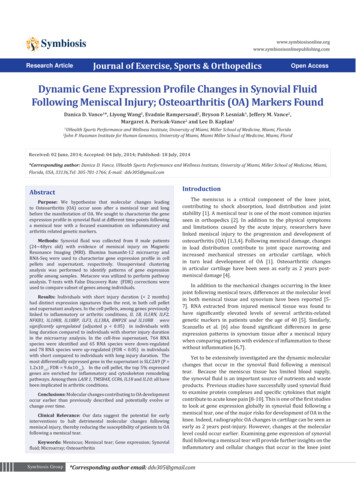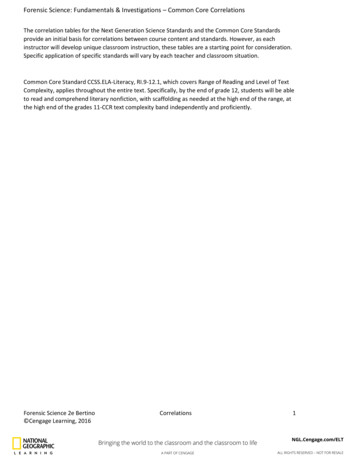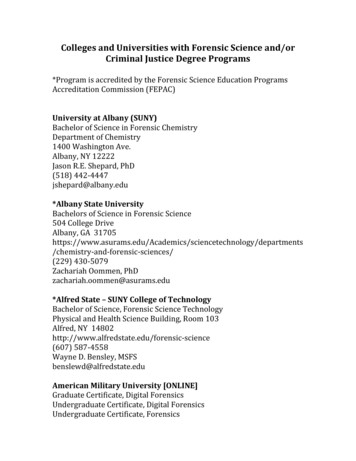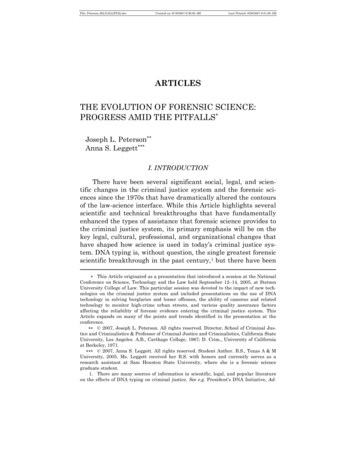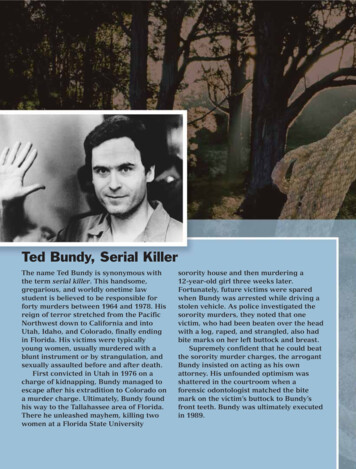
Transcription
Ted Bundy, Serial KillerThe name Ted Bundy is synonymous withthe term serial killer. This handsome,gregarious, and worldly onetime lawstudent is believed to be responsible forforty murders between 1964 and 1978. Hisreign of terror stretched from the PacificNorthwest down to California and intoUtah, Idaho, and Colorado, finally endingin Florida. His victims were typicallyyoung women, usually murdered with ablunt instrument or by strangulation, andsexually assaulted before and after death.First convicted in Utah in 1976 on acharge of kidnapping, Bundy managed toescape after his extradition to Colorado ona murder charge. Ultimately, Bundy foundhis way to the Tallahassee area of Florida.There he unleashed mayhem, killing twowomen at a Florida State Universitysorority house and then murdering a12-year-old girl three weeks later.Fortunately, future victims were sparedwhen Bundy was arrested while driving astolen vehicle. As police investigated thesorority murders, they noted that onevictim, who had been beaten over the headwith a log, raped, and strangled, also hadbite marks on her left buttock and breast.Supremely confident that he could beatthe sorority murder charges, the arrogantBundy insisted on acting as his ownattorney. His unfounded optimism wasshattered in the courtroom when aforensic odontologist matched the bitemark on the victim’s buttock to Bundy’sfront teeth. Bundy was ultimately executedin 1989.
Key Termsexpert witnessLocard’s exchange principlescientific method
4 CHAPTER 1Learning ObjectivesAfter studying this chapter you should be able to: Define forensic science and list the major disciplines itencompasses. Recognize the major contributors to the development offorensic scienceCompare and contrast the Frye and Daubert decisionsrelating to the admissibility of scientific evidence in thecourtroom Account for the rapid growth of forensic laboratories inthe past forty yearsExplain the role and responsibilities of the expertwitness List the specialized forensic services, aside from thecrime laboratory, that are generally available to lawenforcement personnel.Describe the services of a typical comprehensive crimelaboratory in the criminal justice systemDefinition and Scopeof Forensic ScienceForensic science in its broadest definition is the application of science tolaw. As our society has grown more complex, it has become more dependent on rules of law to regulate the activities of its members. Forensic science applies the knowledge and technology of science to the definition andenforcement of such laws.Each year, as government finds it increasingly necessary to regulatethe activities that most intimately influence our daily lives, science mergesmore closely with civil and criminal law. Consider, for example, the lawsand agencies that regulate the quality of our food, the nature and potencyof drugs, the extent of automobile emissions, the kind of fuel oil we burn,the purity of our drinking water, and the pesticides we use on our cropsand plants. It would be difficult to conceive of any food and drug regulation or environmental protection act that could be effectively monitoredand enforced without the assistance of scientific technology and the skill ofthe scientific community.Laws are continually being broadened and revised to counter thealarming increase in crime rates. In response to public concern, law enforcement agencies have expanded their patrol and investigative functions, hoping to stem the rising tide of crime. At the same time they arelooking more to the scientific community for advice and technical supportfor their efforts. Can the technology that put astronauts on the moon, splitthe atom, and eradicated most dreaded diseases be enlisted in this criticalbattle?Unfortunately science cannot offer final and authoritative solutions toproblems that stem from a maze of social and psychological factors. However, as the contents of this book attests, science occupies an importantand unique role in the criminal justice system—a role that relates to the scientist’s ability to supply accurate and objective information that reflects theevents that have occurred at a crime scene. A good deal of work remainsto be done if the full potential of science as applied to criminal investigations is to be realized.Considering the vast array of civil and criminal laws that regulate society,forensic science, in its broadest sense, has become so comprehensive a
IntroductionFIGURE 1–1 Scene from CSI, a forensic science television show. Courtesy Picture Desk,Inc./Kobal Collectionsubject as to make a meaningful introductory textbook treatment of its roleand techniques difficult, if not overwhelming. For this reason, we must narrow the scope of the subject. Fortunately, common usage provides us withsuch a limited definition: Forensic science is the application of science tothe criminal and civil laws that are enforced by police agencies in a criminal justice system. Forensic science is an umbrella term encompassing amyriad of professions that bring skills to bear to aid law enforcement officialsin conducting their investigations.The diversity of professions practicing forensic science is illustrated bythe ten sections of The American Academy of Forensic Science, the largestforensic science organization in the world:1. Criminalistics2. Engineering Science3. General4. Jurisprudence5. Odontology6. Pathology/Biology7. Physical Anthropology8. Psychiatry and Behavioral Science9. Questioned Documents10. ToxicologyEven this list of professions is not exclusive. It does not encompass skills suchas fingerprint examination, firearm and tool mark examination, computerand digital data analysis, and photography.5
6 CHAPTER 1Obviously, any intent to author a book covering all of the major activities of forensic science as they apply to the enforcement of criminal andcivil laws by police agencies would be a major undertaking. Thus, this bookwill restrict itself to discussions of the subjects of chemistry, biology,physics, geology, and computer technology, which are useful for determining the evidential value of crime-scene and related evidence. Forensicpathology, psychology, anthropology, and odontology encompass important and relevant areas of knowledge and practice in law enforcement,each being an integral part of the total forensic science service that is provided to any up-to-date criminal justice system. However, except for briefdiscussions, along with pointing the reader to relevent websites, these subjects go beyond the intended scope of this book, and the reader is referredelsewhere for discussions of their applications and techniques.1 Instead,we will attempt to focus on the services of what has popularly becomeknown as the crime laboratory, where the principles and techniques of thephysical and natural sciences are practiced and applied to the analysis ofcrime-scene evidence.For many, the term criminalistics seems more descriptive than forensicscience for describing the services of a crime laboratory. Regardless oftitle—criminalist or forensic scientist—the trend of events has made thescientist in the crime laboratory an active participant in the criminal justicesystem.History and Developmentof Forensic ScienceForensic science owes its origins first to the individuals who developed theprinciples and techniques needed to identify or compare physical evidence, and second to those who recognized the need to merge these principles into a coherent discipline that could be practically applied to acriminal justice system.The roots of forensic science reach back many centuries, and historyrecords a number of instances in which individuals used close observationof evidence and applied basic scientific principles to solve crimes. Not until relatively recently, however, did forensic science take on the more careful and systematic approach that characterizes the modern discipline.Early DevelopmentsOne of the earliest records of applying forensics to solve criminal casescomes from third-century China. A manuscript titled Yi Yu Ji (“A Collection of Criminal Cases”) reports how a coroner solved a case in which awoman was suspected of murdering her husband and burning the body,then claiming that he died in an accidental fire. Noticing that the husband’s corpse had no ashes in its mouth, the coroner performed an experiment to test the woman’s story. He burned two pigs—one alive andone dead—and then checked for ashes inside the mouth of each. He foundashes in the mouth of the pig that was alive before it was burned, but nonein the mouth of the pig that was dead beforehand. The coroner thus concluded that the husband, too, was dead before his body was burned. Confronted with this evidence, the woman admitted her guilt. The Chinesewere also among the first to recognize the potential of fingerprints as ameans of identification.
IntroductionWhile cases such as that of the Chinese coroner are noteworthy, thiskind of scientific approach to criminal investigation was for many years theexception rather than the rule. Limited knowledge of anatomy and pathology hampered the development of forensic science until the late seventeethand early eighteenth centuries. For example, the first recorded notes aboutfingerprint characteristics were prepared in 1686 by Marcello Malpighi, aprofessor of anatomy at the University of Bologna in Italy. Malpighi, however, did not acknowledge the value of fingerprints as a method of identification. The first scientific paper about the nature of fingerprints did notappear until more than a century later, but that work also did not recognizetheir potential as a form of identification.Initial Scientific AdvancesAs physicians gained a greater understanding of the workings of the body,the first scientific treatises on forensic science began to appear, such as the1798 work “A Treatise on Forensic Medicine and Public Health” by theFrench physician François-Emanuel Fodéré. Breakthroughs in chemistryat this time also helped forensic science take significant strides forward. In1775, the Swedish chemist Carl Wilhelm Scheele devised the first successful test for detecting the poison arsenic in corpses. By 1806, the Germanchemist Valentin Ross had discovered a more precise method for detectingsmall amounts of arsenic in the walls of a victim’s stomach. The most significant early figure in this area was Mathieu Orfila, a Spaniard who isconsidered the father of forensic toxicology. In 1814, Orfila published thefirst scientific treatise on the detection of poisons and their effects on animals. This treatise established forensic toxicology as a legitimate scientificendeavor.FIGURE 1-2 Mathieu Orfila.Courtesy The Granga Collection,New York7
8 CHAPTER 1The mid-1800s saw a spate of advances in several scientific disciplinesthat furthered the field of forensic science. In 1828, William Nichol invented the polarizing microscope. Eleven years later, Henri-Louis Bayardformulated the first procedures for microscopic detection of sperm. Otherdevelopments during this time included the first microcrystalline test forhemoglobin (1853) and the first presumptive test for blood (1863). Suchtests soon found practical applications in criminal trials. Toxicological evidence at trial was first used in 1839, when a Scottish chemist named JamesMarsh testified on the detection of arsenic in a victim’s body. During the1850s and 1860s, the new science of photography was also used in forensics, recording images of prisoners and crime scenes.Late Nineteenth-Century ProgressBy the late nineteenth-century, public officials were beginning to applyknowledge from virtually all scientific disciplines to the study of crime.Anthropology and morphology (the study of the structure of living organisms) were applied to the first system of personal identification, devised bythe French scientist Alphonse Bertillon in 1879. Bertillon’s system, whichhe dubbed anthropometry, was a systematic procedure that involved taking a series of body measurements as a means of distinguishing one individual from another. For nearly two decades, this system was consideredthe most accurate method of personal identification, before being replacedby fingerprinting in the early 1900s. Bertillon’s early efforts earned him thedistinction of being known as the father of criminal identification.Bertillon’s anthropometry, however, would soon be supplanted by themore reliable method of identification by fingerprinting. Two years beforethe publication of Bertillon’s system, the U.S. microscopist Thomas Taylorsuggested that fingerprints could be used as a means of identification, buthis ideas were not immediately followed up. Three years later, the Scottishphysician Henry Faulds made a similar assertion in a paper published inthe journal Nature. However, the Englishman Francis Henry Galton undertook the first definitive study of fingerprints and developed a methodology of classifying them for filing. In 1892, Galton published a book titledFinger Prints, which contained the first statistical proof supporting theuniqueness of his method of personal identification. His work went on todescribe the basic principles that form the present system of identificationby fingerprints.The first treatise describing the application of scientific disciplines to thefield of criminal investigation was written by Hans Gross in 1893. Gross, apublic prosecutor and judge in Graz, Austria, spent many years studyingand developing principles of criminal investigation. In his classic book,Handbuch für Untersuchungsrichter als System der Kriminalistik (later published in English under the title Criminal Investigation), he detailed the assistance that investigators could expect from the fields of microscopy,chemistry, physics, mineralogy, zoology, botany, anthropometry, and fingerprinting. He later introduced the forensic journal Archiv für KriminalAnthropologie und Kriminalistik, which still reports improved methods ofscientific crime detection.Ironically, the best-known figure in nineteenth-century forensics wasnot a real person, but a fictional character, the legendary detective SherlockHolmes. Many people today believe that Holmes’s creator, Sir ArthurConan Doyle, had a considerable influence on popularizing scientificcrime-detection methods. In adventures with his partner and biographer,Dr. John Watson, Holmes first applied the newly developing principles of
FIGURE 1–3 Bertillon’s system of bodily measurements as used for the identification of anindividual. Courtesy Sirchie Finger Print Laboratories, Inc., Youngsville, N.C., www.sirchie.com9
10CHAPTER 1serology (the study of blood and bodily fluids), fingerprinting, firearmsidentification, and questioned-document examination long before theirvalue was recognized and accepted by real-life criminal investigators.Holmes’s feats excited the imagination of an emerging generation of forensic scientists and criminal investigators. Even in the first Sherlock Holmesnovel, A Study in Scarlet, published in 1887, we find examples of Doyle’suncanny ability to describe scientific methods of detection years beforethey were actually discovered and implemented. For instance, here Holmesprobes and recognizes the potential usefulness of forensic serology tocriminal investigation:“I’ve found it. I’ve found it,” he shouted to my companion, runningtowards us with a test tube in his hand. “I have found a reagentwhich is precipitated by hemoglobin and by nothing else. . . . Why,man, it is the most practical medico-legal discovery for years. Don’tyou see that it gives us an infallible test for blood stains? . . . The oldguaiacum test was very clumsy and uncertain. So is the microscopicexamination for blood corpuscles. The latter is valueless if the stainsare a few hours old. Now, this appears to act as well whether theblood is old or new. Had this test been invented, there are hundredsof men now walking the earth who would long ago have paid thepenalty of their crimes. . . . Criminal cases are continually hingingupon that one point. A man is suspected of a crime months perhapsafter it has been committed. His linen or clothes are examined andbrownish stains discovered upon them. Are they blood stains, orrust stains, or fruit stains, or what are they? That is a question whichhas puzzled many an expert, and why? Because there was no reliable test. Now we have the Sherlock Holmes test, and there will nolonger be any difficulty.”Twentieth-Century BreakthroughsThe pace of technological change quickened considerably in the twentiethcentury, and with it the rate of advancement in the field of forensic science.In 1901, Dr. Karl Landsteiner discovered that blood can be grouped intodifferent categories, now recognized as the blood types A, B, AB, and O.The possibility that blood grouping could be useful in identifying an individual intrigued Dr. Leone Lattes, a professor at the Institute of ForensicMedicine at the University of Turin in Italy. In 1915, Lattes devised a relatively simple procedure for determining the blood group of a dried bloodstain, a technique that he immediately applied to criminal investigations.At around the same time, Albert S. Osborn was conducting pioneeringwork in document examination. In 1910, Osborn wrote the first significanttext in this field, Questioned Documents. This book is still considered a primary reference for document examiners. Osborn’s development of the fundamental principles of document examination was responsible for theacceptance of documents as scientific evidence by the courts.One of the most important contributors to the field in the early twentiethcentury was the Frenchman Edmond Locard. Although Hans Gross was apioneer advocate of the use of the scientific method in criminal investigation, Locard first demonstrated how the principles enunciated by Grosscould be incorporated within a workable crime laboratory. Locard’s formaleducation was in both medicine and law. In 1910, he persuaded the Lyonspolice department to give him two attic rooms and two assistants to start
Introduction 11FIGURE 1–4 Sir ArthurConan Doyle’s legendarydetective Sherlock Holmesapplied many of theprinciples of modern forensicscience long before theywere adopted widely bypolice. Paul C. Chauncey/CORBIS. All rights reserved.a police laboratory. During Locard’s first years of work, the only availableinstruments were a microscope and a rudimentary spectrometer. However, his enthusiasm quickly overcame the technical and monetary deficiencies he encountered. From these modest beginnings, Locard’sresearch and accomplishments became known throughout the world byforensic scientists and criminal investigators. Eventually he became thefounder and director of the Institute of Criminalistics at the University ofLyons; this quickly developed into a leading international center for studyand research in forensic science.Locard asserted that when two objects come into contact with eachother, a cross-transfer of materials occurs (Locard’s exchange principle).He strongly believed that every criminal can be connected to a crime bydust particles carried from the crime scene. This concept was reinforcedby a series of successful and well-publicized investigations. In one case,presented with counterfeit coins and the names of three suspects, Locardurged the police to bring the suspects’ clothing to his laboratory. On careful examination, he located small metallic particles in all the garments.Chemical analysis revealed that the particles and coins were composed ofexactly the same metallic elements. Confronted with this evidence, the suspects were arrested and soon confessed to the crime. After World War I,Locard’s exchangeprincipleWhen two objects comeinto contact with eachother, a cross-transfer ofmaterials occurs.
12CHAPTER 1FIGURE 1–5 Edmond Locard. Courtesy Collection of Roger-Viollet, The Image WorksLocard’s successes served as an impetus for the formation of police laboratories in Vienna, Berlin, Sweden, Finland, and Holland.The microscope came into widespread use in forensic science duringthe twentieth century, and its applications grew dramatically. Perhaps theleading figure in the field of microscopy was Dr. Walter C. McCrone. During his lifetime, McCrone became the world’s preeminent microscopist.Through his books, journal publications, and research institute, he was atireless advocate for applying microscopy to analytical problems, particularly forensic science cases. McCrone’s exceptional communication skillsmade him a much-sought-after instructor, and he educated thousands offorensic scientists throughout the world in the application of microscopictechniques. Dr. McCrone used microscopy, often in conjunction with otheranalytical methodologies, to examine evidence in thousands of criminaland civil cases throughout a long and illustrious career.Another trailblazer in forensic applications of microscopy was U.S.Army Colonel Calvin Goddard, who refined the techniques of firearms examination by using the comparison microscope. Goddard’s work allowedinvestigators to determine whether a particular gun has fired a bullet bycomparing the bullet with one that has been test-fired from the suspect’sweapon. His expertise established the comparison microscope as theindispensable tool of the modern firearms examiner.
Introduction 13Modern Scientific AdvancesSince the mid-twentieth century, a revolution in computer technology hasmade possible a quantum leap forward in human knowledge. The resulting explosion of scientific advances has dramatically impacted the field offorensic science by introducing a wide array of sophisticated techniquesfor analyzing evidence related to a crime. Procedures such as chromatography, spectrophotometry, and electrophoresis (all discussed in later chapters) allow the modern forensic scientist to determine with astoundingaccuracy the identity of a suspect substance, and to connect even tiny fragments of evidence to a particular person and place.The most significant modern advance in forensic science undoubtedlyhas been the discovery and refinement of DNA typing in the late twentiethand early twenty-first centuries. Sir Alec Jeffreys developed the first DNAprofiling test in 1984, and two years later he applied it for the first time tosolve a crime by identifying Colin Pitchfork as the murderer of two youngEnglish girls. The same case also marked the first time DNA profiling established the innocence of a criminal suspect. Made possible by scientificbreakthroughs in the 1950s and 1960s, DNA typing offers law enforcementofficials a powerful tool for establishing the precise identity of a suspect,even when only a small amount of physical evidence is available. Combined with the modern analytical tools mentioned earlier, DNA typing hasrevolutionized the practice of forensic science.Another significant recent development in forensics is the establishment of computerized databases on physical evidence such as fingerprints,markings on bullets and shell casings, and DNA. These databases haveproven to be invaluable, enabling law enforcement officials to compare evidence found at crime scenes to records of thousands of pieces of similarinformation. This has significantly reduced the time required to analyze evidence and increased the accuracy of the work done by police and forensicinvestigators.FIGURE 1–6 Sir Alec Jeffreys. Courtesy Homer Sykes, Alamy Images Royalty Free
14CHAPTER 1While this brief narrative is by no means a complete summary of historical advances in forensics, it provides an idea of the progress made inthe field by dedicated scientists and law enforcement personnel. EvenSherlock Holmes probably couldn’t have imagined the lengths to whichscience today is applied in the service of criminal investigation.Key Points Forensic science is the application of science to criminal and civil lawsthat are enforced by police agencies in a criminal justice system. The first system of personal identification was called anthropometry. Itdistinguished one individual from another based on a series of bodymeasurements. Forensic science owes its origins to individuals such as Bertillon, Galton, Lattes, Goddard, Osborn, and Locard, who developed the principles and techniques needed to identify or compare physical evidence. Locard’s exchange principle states that when two objects come intocontact with each other, a cross-transfer of materials occurs that canconnect a criminal suspect to his or her victim.Crime LaboratoriesThe steady advance of forensic science technologies during the twentiethcentury led to the establishment of the first facilities specifically dedicatedto forensic analysis of criminal evidence. These crime laboratories are nowthe centers for both forensic investigation of ongoing criminal cases andresearch into new techniques and procedures to aid investigators in thefuture.History of Crime Labs in the United StatesThe oldest forensic laboratory in the United States is that of the Los AngelesPolice Department, created in 1923 by August Vollmer, a police chief fromBerkeley, California. In the 1930s, Vollmer headed the first U.S. universityinstitute for criminology and criminalistics at the University of Californiaat Berkeley. However, this institute lacked any official status in the university until 1948, when a school of criminology was formed. The famouscriminalist Paul Kirk was selected to head its criminalistics department.Many graduates of this school have gone on to develop forensic laboratories in other parts of the state and country.In 1932, the Federal Bureau of Investigation (FBI), under the directorship of J. Edgar Hoover, organized a national laboratory that offeredforensic services to all law enforcement agencies in the country. During itsformative stages, Hoover consulted extensively with business executives,manufacturers, and scientists whose knowledge and experience guidedthe new facility through its infancy. The FBI Laboratory is now the world’slargest forensic laboratory, performing more than one million examinations every year. Its accomplishments have earned it worldwide recognition, and its structure and organization have served as a model for forensiclaboratories formed at the state and local levels in the United States as wellas in other countries. Furthermore, the opening of the FBI’s Forensic Science Research and Training Center in 1981 gave the United States, for the
Introduction 15(a)(b)FIGURE 1–7 (a) Exterior and (b) interior views of the FBI crime laboratory in Quantico,Virginia. Courtesy AP Wide World Photosfirst time, a facility dedicated to conducting research to develop new andreliable scientific methods that can be applied to forensic science. This facility is also used to train crime laboratory personnel in the latest forensicscience techniques and methods.Despite the existence of the FBI Laboratory, the United States has no national system of forensic laboratories. Instead, many local law enforcementjurisdictions—city, county, and state—around the country each operatetheir own independent crime labs. California, for example, has numerousfederal, state, county, and city crime laboratories, many of which operateindependently. However, in 1972 the California Department of Justice created a network of integrated state-operated crime laboratories consistingof regional and satellite facilities. An informal exchange of information andexpertise occurs within California’s criminalist community through a regional professional society, the California Association of Criminalists. Thisorganization was the forerunner of a number of regional organizations thathave developed throughout the United States to foster cooperation amongthe nation’s growing community of criminalists.Organization of a Crime LaboratoryThe development of crime laboratories in the United States has been characterized by rapid growth accompanied by a lack of national and regionalplanning and coordination. Approximately 350 public crime laboratoriesoperate at various levels of government—federal, state, county, and municipal. The size and diversity of crime laboratories make it impossible to select any one model that best describes a typical crime laboratory. Althoughmost of these facilities function as part of a police department, others operate under the direction of the prosecutor’s or district attorney’s office; somework with the laboratories of the medical examiner or coroner. Far fewerare affiliated with universities or exist as independent agencies in government. Laboratory staff sizes range from one person to more than 100, andtheir services may be diverse or specialized, depending on the responsibilities of the agency that houses the laboratory.The Growth of Crime Laboratories Crime laboratories have mostly been organized by agencies that either foresaw their potential application to criminal investigation or were pressed by the increasing demands of casework.Several reasons explain the unparalleled growth of crime laboratories during the past forty years. Supreme Court decisions in the 1960s compelled
16CHAPTER 1police to place greater emphasis on securing scientifically evaluated evidence. The requirement to advise criminal suspects of their constitutionalrights and their right of immediate access to counsel has all but eliminatedconfessions as a routine investigative tool. Successful prosecution of criminal cases requires a thorough and professional police investigation, frequently incorporating the skills of forensic science experts. Moderntechnology has provided forensic scientists with many new skills and techniques to meet the challenges accompanying their increased participationin the criminal justice system.Coinciding with changing judicial requirements has been the staggering increase in crime rates in the United States over the past forty years.This factor alone would probably have accounted for the increased use ofcrime
4 CHAPTER 1 Define forensic science and list the major disciplines it encompasses. Recognize the major contributors to the development of forensic science Account for the rapid growth of forensic laboratories in the past forty years Describe the services of a typical comprehensive crime laboratory in the criminal j




